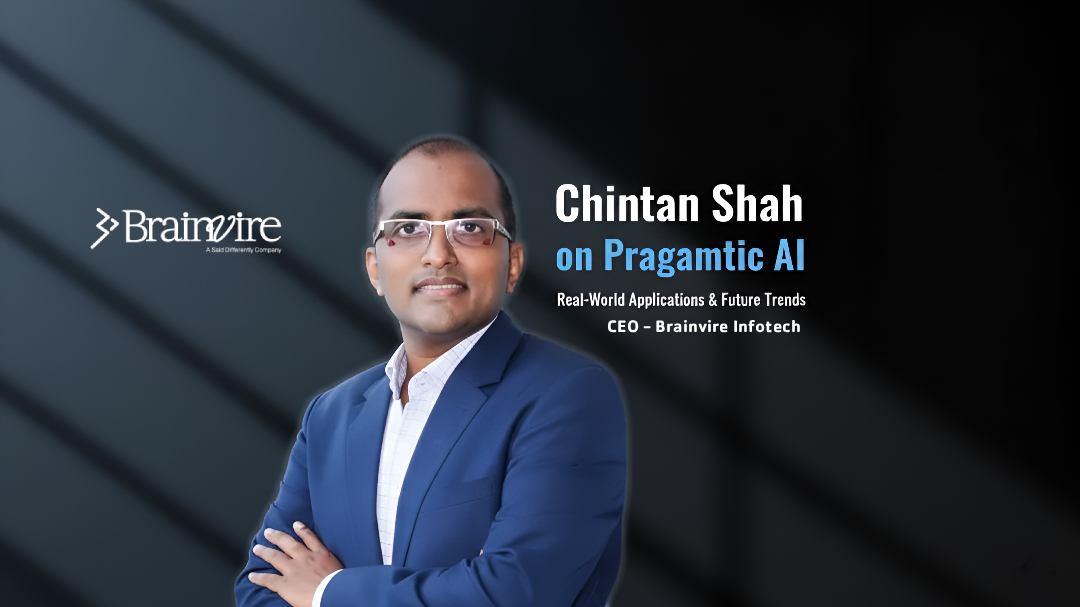Chintan Shah on Pragmatic AI – From Hype to Business Outcomes

The conversation covered data readiness, responsible deployment of AI ML development, and how leaders should judge ROI in the first 90 days.
Everyone says AI changes everything. What’s actually different now for CEOs?
Chintan Shah: Cost and accessibility. Five years ago, only a handful of firms could experiment with language and vision models at scale. Today, you can stand up a working pilot in weeks, if your data is in shape and your processes are clear. The shift is from “can we do AI?” to “where will AI remove effort right now?”
Where do you tell clients to start?
Chintan: Start with one job that repeats, has clear success criteria, and directly impacts revenue or cost. Think “answer product questions that cause cart exits,” or “pre-qualify and route service tickets with context.” Finish that, measure it weekly, then move to the next. Broad roadmaps look impressive, but Brainvire’s experience shows that narrow, focused wins build real momentum and prevent software development efforts from slowing down.
What separates a good pilot from a program that lasts?
Chintan: Ownership and grounding. Give each use case an “operator” who can change prompts, rules, and thresholds without filing a ticket. And ground every answer in your truths (catalog, policies, entitlements) so the system advises from facts, not the internet. That’s how you scale without surprises.
Leaders worry about hallucinations. How do you keep systems honest?
Chintan: Retrieval and rules. We pair models with a retrieval layer that only serves approved content and attach simple guardrails: topics you can answer, topics you must escalate, confidence bands, and safe templates when context is thin. Money, eligibility, and compliance stay deterministic through APIs. That blend is boring—and that’s the point.
What early KPIs actually prove value?
Chintan: Tie metrics to the job. For customer assistants, measure verified resolution and 72-hour reopens, not “containment.” For sales, focus on qualified demos and win rate, rather than raw leads. For operations, track on-time in-full, backlog clearance time, and p95 handling latency. If a feature does not move its number in two sprints, change it or retire it.
How do you think about build vs. buy?
Chintan: Buy for the plumbing: observability, prompt/version control, security, and connectors. Build where you compete: your flows, your voice, and how you use your data. Off-the-shelf tools can draft content, but your advantage lies in creating grounded content that reflects your products, return rules, and support realities.
Some executives still view AI as an add-on. What’s your argument for “system, not feature”?
Chintan: Features stall when people change; systems survive. If you treat AI as a system, you can manage data contracts, review tiers, change logs, and owners, allowing you to swap models, upgrade prompts, and maintain steady outcomes. If you treat it as a widget, it works until one policy or price changes.
Where are you seeing quick wins outside of customer support?
Chintan: Three areas. First, product pages: turning dense specs into clear benefits and compatibility notes cuts returns. Second, finance ops: document extraction for AP/AR with human review speeds close without risking controls. Third, field service: summarizing logs and recommending next actions shortens time on site.
How do you resource this? The talent market is tight.
Chintan: You need fewer specialists than you think. A lean team works: one product manager who loves process, one data engineer who can create clean events and features, and one application engineer who knows your systems. Partner selectively to accelerate, especially with an AI ML development company, Brainvire, that brings patterns you can keep after hand-off.
What’s your view on Generative AI Solutions versus classical ML?
Chintan: Use the right tool. Generative shines at conversation, drafting, summarizing, and searching over messy text. Classical ML still wins on forecasting, ranking, fraud, and optimization—anything that needs stable, numeric predictions. The magic is the seam: a conversational layer that collects clean signals and a traditional model that makes the decision.
Chintan: A short list of golden events (search, add-to-cart, checkout, support case) with stable names and fields. A basic feature store for recency, frequency, and value. Clear tags for sensitive data. You do not need a lake first; you need a tidy stream. Clean edges beat big lakes.
Responsible AI is on every agenda. How should a CEO think about it practically?
Chintan: Treat it like safety. Define the use, the risk, and the controls. Keep a register of models, prompts, and data sources. Set review tiers: low-risk edits can ship with automated checks; high-risk flows get human sign-off. Provide appeal paths for decisions that affect people. And train teams to recognize when the system should not answer.
What does a sane 90-day plan look like?
Chintan: Month one: pick one use case, wire retrieval to approved content, and ship a controlled pilot to a small audience. Month two: add observability, handoff payloads, and weekly reviews (resolution, reopens, latency, and outliers). Month three: expand coverage, tighten prompts, and write the runbook. If you cannot write how it works on one page, it’s not ready to scale.
Any missteps you still see too often?
Chintan: Three, namely:
- Launching without a handoff schema, so agents re-ask basics.
- Over-personalizing without consent creates risk for little gain.
- Chasing “containment” looks great until you measure the reopens.
Remember, it’s about making mistakes while you adapt, not the other way round!



